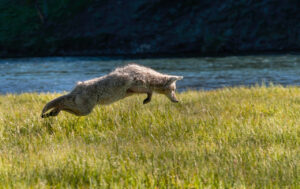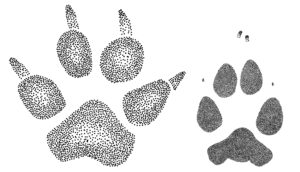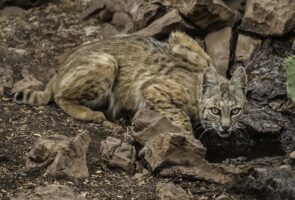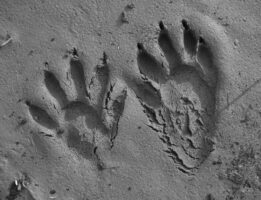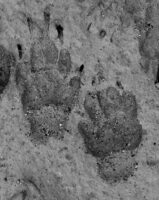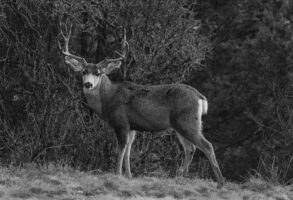Six Animal Tracks to Look for on Your Next Hike
Sharman Apt Russell
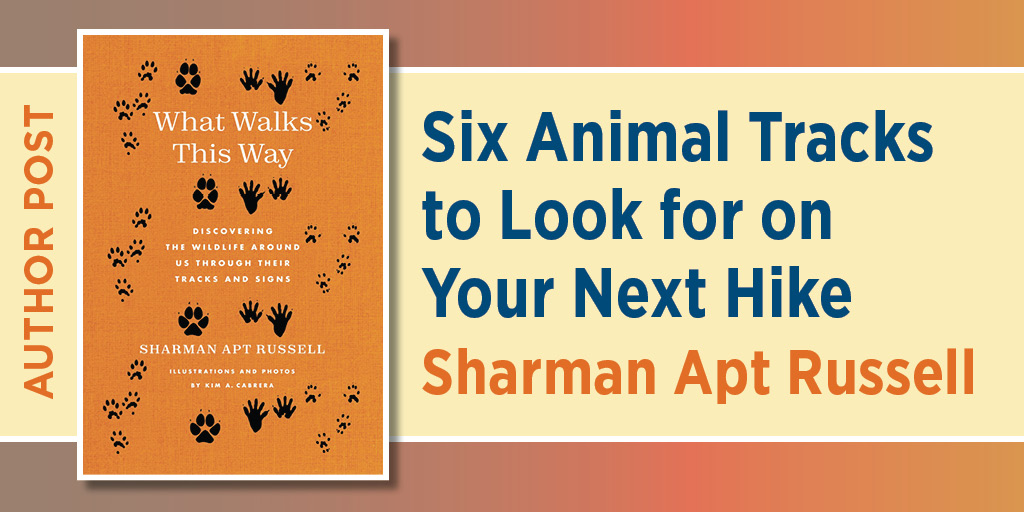
Imagine walking along a forested mountain trail and coming across footprints impressed in the dirt. You think, “Do they belong to a fox, a bobcat, or a coyote? What animal fits these marks on the ground?” Combining lyrical memoir with an introduction to wildlife tracking, What Walks This Way: Discovering the Wildlife Around Us Through Their Tracks and Signs explores the joys of learning to recognize the traces of the creatures with whom we share our world.
Written by nature writer Sharman Apt Russell, who lives in the magical realism of rural New Mexico, and with photographs and illustrations by master tracker and well-known wildlife tracking educator Kim A. Cabrera, this book aims to celebrate wild animals and encourage readers to reflect on our current understandings of ecology. In the list below, this award-winning author offers delightful tips for identifying tracks and signs during your next hike.
Coyote
Many animals like to walk on the same hiking trail you follow—because that’s the easiest way to get from point A to point B. Like a domestic dog track, a coyote track will have four toe pads, a palm pad with a single lobe or point at the top, and the shape of an X in the “negative space” between the toes and the palm. Unlike most domestic dog tracks, the toes do not splay to the side and the show of claws are elegant pinpricks. (The claw marks of a domestic dog are often big and blunted from clacking about on hard surfaces.) The length from claw marks to the bottom of the pad ranges from 2½ to 3½ inches. Everything about this oval track is compact and purposeful—an animal moving through the world on serious business.
Bobcat
If you have watched house cats, you have seen bobcats. Obviously, they are not the same species. Adult bobcats are generally larger, with spotted coats, 6-inch tails, pointed ears with black tufts, and hair in a whiskery ruff around the cheeks. But bobcat kittens, with their round blue eyes, have the same manic innocence as domestic kittens. Young bobcats play together like your cats, ballerina movements, chest and paws raised in slow motion—and then the race begins. Next time you look, they’re grooming each other. Bobcats also purr with that grumbling feline seduction, drilling into your maternal instinct, filing down any species mistrust. Their round tracks are about 1½ to 2½ inches long, with four toes and a large palm pad with two lobes or points at the top and three lobes at the bottom. Unlike most members of the dog family, cats can retract their claws, and the claws of a bobcat do not usually show. Also unlike with dogs, you could not trace an X in the negative space without bisecting a palm pad. Form follows function, and the track of a small bobcat might look like the track of a large domestic cat, just as the track of a small mountain lion might look like that of a big bobcat. There are subtle differences, but you’ll need to get on your knees, maybe flat on the ground, and look hard to see them.
Raccoon
Wonderfully often, the shape, size, and robust quality of a raccoon track practically scream “Raccoon!” The five long fingerlike toes are usually connected to the palm pad. The claw marks sometimes show. Front tracks can resemble—a little unnervingly—small human handprints. Hind tracks can look like small human footprints. Because of this animal’s gait, a front track is often side by side with a hind track. You’ll see big and small raccoons, with tracks 1½ to over 3 inches long. Examine, in particular, the bank of any stream or pond.
Skunk
Mostly we see the solitary skunk in our garden or backyard. It’s like a fashion show. Something from Chanel. A bit of art deco. That black-and-white aesthetic. With their strong defensive strategies, skunks are seemingly carefree, and their small tracks—1½ to 2 inches long—can be seen on many trails. They go where they want to go. Look for five toes and triangular-shaped palm pads and smaller heel pads. Because these are digging animals, the long claws in the front tracks often show. Unlike the raccoon, the three middle toes are fused and do not splay. These tracks too can resemble a hand with fingers together, palm facing you, in the universal gesture of stop.
Black Bear
Wild animals do not want to be seen. We can understand why, since they are typically prey to our predator. But with more than 300,000 black bears in the United States and their populations on the rise, you are likely to see their tracks. You will feel that thrill. The hind track can be as long as 8 inches, strongly evoking the human footprint, with the big toe on the outside—the opposite of our own feet.
Deer
In the heart-shaped tracks of the two-toed deer, the sharp tips point in the direction of travel. These hooves are a miracle of evolution, allowing the animal to run faster than the many species of canines and felines that were also evolving to run fast. In white-tailed and mule deer, the two middle toes retreated behind a thick horny covering with a hard nail rolled around the edge. The two outer toes became reduced, higher up on the leg as dewclaws. A fifth toe disappeared. The rest of the foot elongated and become part of the leg, which increased length of stride, with a second springy joint to push the leg forward, which increased rate of stride. All this meant more speed. Deer are among the animals that have managed to flourish in our human-dominated world. We celebrate their resilience and beauty, the way they lift their heads—always vigilant—and move fleetly through the trees, disappearing into their secret lives.

